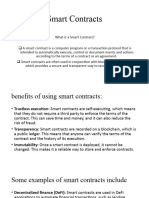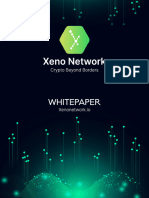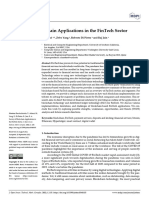0% found this document useful (0 votes)
24 views14 pagesModule-4 Block Chain and Its Applications
A smart contract is a self-executing program on a blockchain that enforces agreements without intermediaries, characterized by automation, trustlessness, immutability, and transparency. In Ethereum, smart contracts are written in Solidity, compiled into bytecode, deployed on the blockchain, and interact via a unique contract address. Hyperledger Fabric, on the other hand, is a permissioned blockchain designed for enterprise use, offering privacy, modularity, and scalability, making it suitable for business applications.
Uploaded by
shaikkasifnawaz7866Copyright
© © All Rights Reserved
We take content rights seriously. If you suspect this is your content, claim it here.
Available Formats
Download as PDF, TXT or read online on Scribd
0% found this document useful (0 votes)
24 views14 pagesModule-4 Block Chain and Its Applications
A smart contract is a self-executing program on a blockchain that enforces agreements without intermediaries, characterized by automation, trustlessness, immutability, and transparency. In Ethereum, smart contracts are written in Solidity, compiled into bytecode, deployed on the blockchain, and interact via a unique contract address. Hyperledger Fabric, on the other hand, is a permissioned blockchain designed for enterprise use, offering privacy, modularity, and scalability, making it suitable for business applications.
Uploaded by
shaikkasifnawaz7866Copyright
© © All Rights Reserved
We take content rights seriously. If you suspect this is your content, claim it here.
Available Formats
Download as PDF, TXT or read online on Scribd
/ 14


























































































